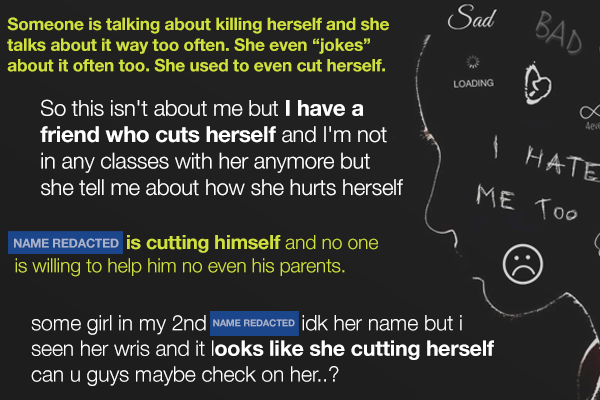Kids Seeking Help: How to Address Escalation of Emergent Incidents in K12
Emergent incidents have skyrocketed during the 2023-2024 school year. Emergent incidents refer to unexpected events that require immediate attention and first responder response. They are often serious or critical situations.
Emergent incidents make up 8.2% of all incidents reported daily, up 23% this school year after being up 38% last year. This means that for every 500 daily events, more than 30 people require immediate help. Suicide and mental health concerns are now nearly two and a half times more likely to be the cause of student reports versus incidents involving weapons and violence, which have remained concerningly high.
Here is just a sample of what we see every day.

Safety and Mental Health Wellness are Top-of-Mind for Parents
According to federal data, public school enrollment fell by 3% during the first year of the pandemic and is continuing to decline. For example, Boston Public Schools expects another 4.9% decline by 2030. Declining birth rates and changing migration patterns account for some expected declines, but parents also choose alternatives to public schools. USA Today reports that more than half of those "school-switching parents" said "that they want better or safer education environments for their children."
Why are parents considering alternative schooling options? In a previous blog post, we discussed this in detail, but the top reasons are concerns about mental health, academic performance, social and development, and physical wellbeing.
In another recent study, parents were asked why they homeschooled their children. The top reasons cited were school safety issues such as school shootings, drugs, and negative peer pressure, religious or moral instruction that aligns with their beliefs, and academic instruction. Source
Regardless of what study you read, the top reasons why parents pull their kids out of public school are concerns about mental health, safety, and academic instruction/performance.
Kids Want Help
These trends are disturbing, but kids' actions to seek help for themselves and their peers bring hope.
Everyone is responsible for protecting and supporting our children through every means possible. This goes beyond academic success; it encompasses their mental and emotional well-being. Our schools must be safe havens where staff and students feel safe, supported, and valued. It is only then that teachers can teach and students can learn.
While not new, the fact that so many students are feeling unsafe and unsupported is a wake-up call for much of society. It reminds us that we cannot afford to be complacent or assume that these issues will resolve themselves. We can’t rely on people to shout their needs; they shouldn’t have to. Kids don’t act that way—they communicate in more comfortable ways: discreetly, via social media, texting, and other ways using their myriad devices.
50% of Districts Don’t Have Tools
Despite the growing recognition of student mental health needs, there are several reasons why an estimated 50% of school districts lack proper mental health and wellness programs, along with school safety tools. Funding shortfalls are a major hurdle, with districts often struggling to allocate resources for qualified mental health professionals like counselors and social workers. The stigma surrounding mental health can also be a barrier, making it difficult for schools and communities to address the issue openly. Additionally, logistical challenges exist in implementing effective programs, including a lack of training for staff and difficulty in integrating mental health services into the existing school structure. These factors contribute to the concerning reality that half of our school districts are not fully equipped to support student well-being and safety.
Funding is Available – If you can Access It
Funding is available through various resources for mental health and safety programs. The process may seem overwhelming, but funding experts are available to help you navigate it. The time is now to reach out for key safety and wellness grant partnerships. Learn more here: Funding Mental Health in Schools: Navigating the Maze (and Finding the Money Now!).
Take Action Now
STOPit Solutions can help. We can assist your district with funding, training, and logistics for creating and implementing a comprehensive program. We partner with more than 1600 districts nationwide.
Download the case study below to learn how we helped Kansas City Kansas Public Schools with their program. It is a great success story from day one, helping the district create and transform into a more resilient and safe school culture.



